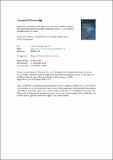Files in this item
Evaluation of estuarine biotic indices to assess macro-benthic structure and functioning following nutrient remediation actions : a case study on the Eden estuary Scotland
Item metadata
| dc.contributor.author | Watson, Stephen C. L. | |
| dc.contributor.author | Paterson, David M. | |
| dc.contributor.author | Widdicombe, Stephen | |
| dc.contributor.author | Beaumont, Nicola J. | |
| dc.date.accessioned | 2019-10-11T23:37:18Z | |
| dc.date.available | 2019-10-11T23:37:18Z | |
| dc.date.issued | 2018-11 | |
| dc.identifier | 256213752 | |
| dc.identifier | 26527938-76cb-4bfc-a6a2-55830e65df08 | |
| dc.identifier | 85055111680 | |
| dc.identifier | 000449553500038 | |
| dc.identifier.citation | Watson , S C L , Paterson , D M , Widdicombe , S & Beaumont , N J 2018 , ' Evaluation of estuarine biotic indices to assess macro-benthic structure and functioning following nutrient remediation actions : a case study on the Eden estuary Scotland ' , Regional Studies in Marine Science , vol. 24 , pp. 379-391 . https://doi.org/10.1016/j.rsma.2018.09.012 | en |
| dc.identifier.issn | 2352-4855 | |
| dc.identifier.other | RIS: urn:15FB877BB4D01912E165DC2B40F6CB74 | |
| dc.identifier.other | ORCID: /0000-0003-1174-6476/work/49580171 | |
| dc.identifier.uri | https://hdl.handle.net/10023/18653 | |
| dc.description | This work was supported by the EU grant MAS3-CT97-0158 ‘BIOPTIS’ and was funded with support from the Biodiversity and Ecosystem Service Sustainability (BESS) programme [NERC Grant Ref: NE/K501244/1]. BESS is a six-year programme (2011–2017) funded by the UK Natural Environment Research Council (NERC) and the Biotechnology and Biological Sciences Research Council (BBSRC) as part of the UK’s Living with Environmental Change (LWEC) programme. DMP also received funding from the MASTS pooling initiative (The Marine Alliance for Science and Technology for Scotland) and their support is gratefully acknowledged. MASTS is funded by the Scottish Funding Council (grant reference HR09011) and contributing institutions. | en |
| dc.description.abstract | Despite a wealth of methods currently proposed by the European Water Framework Directive (WFD) to assess macro-benthic integrity, determining good ecological status (GES) and assessing ecosystem recovery following anthropogenic degradation is still one of the biggest challenges in marine ecology research. In this study, our aim was to test a number of commonly used structural (e.g. Shannon–Wiener, Average Taxonomic Diversity (Δ), M-AMBI) and functional indictors (e.g. BTA, BPc) currently used in benthic research and monitoring programmes on the Eden estuary (Scotland). Historically the estuary has a legacy of high nutrient conditions and was designated as a Nitrate Vulnerable Zone (NVZ) in 2003, whence major management measures were implemented in order to ameliorate the risk of eutrophication symptoms. We therefore collected data on intertidal macro-benthic communities over a sixteen year interval, covering a pre-management (1999) and post-management (2015) period to assess the effectiveness of the intended restoration efforts. In the post-management period, the results suggested an improvement in the structure and functioning of the estuary as a whole, but macro-benthic assemblages responded to restoration variably along the estuarine gradient. The greatest improvements were noticed in the upper and central sites of the estuary with functional traits analysis suggesting an increased ability of these sites to provide ecosystem services associated with the benthic environment such as carbon and organic matter cycling. Generally, almost all of the structural and functional indicators detected the prevailing environmental conditions (with the exception of (Pielou’s index and Average Taxonomic Diversity (Δ)), highlighting the appropriateness of such methods to be used in monitoring the recovery of transitional systems. This research also provides a robust baseline to monitor further management actions in the Eden estuary and provides evidence that notable reductions in nitrate concentrations resulting from NVZ designations may result in significant improvements to benthic structure and functioning. | |
| dc.format.extent | 1060561 | |
| dc.language.iso | eng | |
| dc.relation.ispartof | Regional Studies in Marine Science | en |
| dc.subject | Ecological indicators | en |
| dc.subject | Macro-invertebrates | en |
| dc.subject | Estuarine recovery | en |
| dc.subject | Ecological quality | en |
| dc.subject | M-AMBI | en |
| dc.subject | Biological traits analysis (BTA) | en |
| dc.subject | QH301 Biology | en |
| dc.subject | NDAS | en |
| dc.subject | SDG 14 - Life Below Water | en |
| dc.subject.lcc | QH301 | en |
| dc.title | Evaluation of estuarine biotic indices to assess macro-benthic structure and functioning following nutrient remediation actions : a case study on the Eden estuary Scotland | en |
| dc.type | Journal article | en |
| dc.contributor.institution | University of St Andrews. School of Biology | en |
| dc.contributor.institution | University of St Andrews. Sediment Ecology Research Group | en |
| dc.contributor.institution | University of St Andrews. Marine Alliance for Science & Technology Scotland | en |
| dc.contributor.institution | University of St Andrews. Scottish Oceans Institute | en |
| dc.contributor.institution | University of St Andrews. St Andrews Sustainability Institute | en |
| dc.identifier.doi | https://doi.org/10.1016/j.rsma.2018.09.012 | |
| dc.description.status | Peer reviewed | en |
| dc.date.embargoedUntil | 2019-10-12 |
This item appears in the following Collection(s)
Items in the St Andrews Research Repository are protected by copyright, with all rights reserved, unless otherwise indicated.

